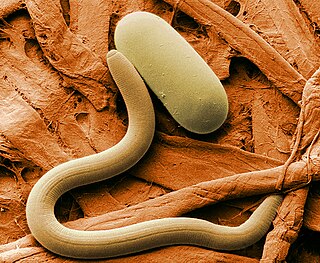| Heterodera trifolii | |
|---|---|
| Scientific classification | |
| Domain: | Eukaryota |
| Kingdom: | Animalia |
| Phylum: | Nematoda |
| Class: | Secernentea |
| Order: | Tylenchida |
| Family: | Heteroderidae |
| Genus: | Heterodera |
| Species: | H. trifolii |
| Binomial name | |
| Heterodera trifolii Goffart, 1932 | |
| Heterodera trifolii | |
|---|---|
| Scientific classification | |
| Domain: | Eukaryota |
| Kingdom: | Animalia |
| Phylum: | Nematoda |
| Class: | Secernentea |
| Order: | Tylenchida |
| Family: | Heteroderidae |
| Genus: | Heterodera |
| Species: | H. trifolii |
| Binomial name | |
| Heterodera trifolii Goffart, 1932 | |
Nathan Augustus Cobb is known as "the father of nematology in the United States".

Rotylenchulus reniformis, the reniform nematode, is a species of parasitic nematode of plants with a worldwide distribution in the tropical and subtropical regions.
Curvularia trifolii is a plant pathogen.

Heterodera avenae, the cereal cyst nematode or European cyst nematode, is a plant pathogen and an obligate parasite of cereal crops including barley, oats, wheat and rye. Cereal crops infected with this nematode are more susceptible to infection by fungal diseases such as rhizoctonia root rot.
Heterodera cajani is a plant pathogenic nematode affecting pigeonpeas, which is cited as an invasive species.
Heterodera carotae is a plant pathogenic nematode commonly known as the carrot root nematode or carrot cyst nematode. It is found in Europe, Cyprus and India and is considered an invasive species in the United States. It causes damage to carrot crops and is very specific in its choice of hosts, only infecting Daucus carota and Daucus pulcherrima.
Heterodera ciceri is a plant pathogenic nematode infecting lentils and chickpeas.
Heterodera filipjevi is a plant pathogenic nematode affecting barley.
Heterodera gambiensis is a plant pathogenic nematode affecting pearl millet.
Heterodera goettingiana, the pea cyst nematode, is a plant pathogenic nematode affecting peas.
Heterodera hordecalis is a plant pathogenic nematode affecting barley.
Heterodera latipons, the Mediterranean cereal cyst nematode or wheat cyst nematode, is a plant pathogenic nematode.

Heterodera schachtii, the beet cyst eelworm or sugarbeet nematode, is a plant pathogenic nematode. It infects more than 200 different plants including economically important crops such as sugar beets, cabbage, broccoli, and radish. H. schachtii is found worldwide. Affected plants are marked by stunted growth, wilting, yellowing, decreased yields, and death. While there are many methods of control, crop rotation with non-susceptible plants is preferred.
Heterodera tabacum is a plant pathogenic nematode affecting Jerusalem cherries.

Heterodera is a genus of nematodes in the family Heteroderidae. Members of the genus are obligate parasites and different species attack different crops, often causing great economic damage. The genus is unique among nematode genera because of the ability of the female to transform into a tough, brown, cyst which protects the eggs which have been formed within her body. The name heterodera "refers to the different 'skins' of female and cyst."
Heterodera sacchari, the sugarcane cyst nematode, mitotic parthenogenic sedentary endoparasitic nematode. This plant-parasitic nematode infects the roots of sugarcane, and the female nematode eventually becomes a thick-walled cyst filled with eggs. Aboveground symptoms are species specific and are similar to those caused by other Heterodera species. Symptoms include: stunted and chlorotic plants, and reduced root growth. Seedlings may be killed in heavily infested soils.
Globodera tabacum, commonly known as a tobacco cyst nematode, is a plant parasitic nematode that mainly infests the tobacco plant, but also plants in family Solanaceae.
Heterodera zeae, the corn cyst nematode (CCN), is a plant parasitic nematode that feeds on Zea mays (maize/corn). The CCN has a limited economic impact worldwide due to its high soil temperature requirements.

The Pasteuriaceae are a family of nonmotile Gram-positive bacteria. They are moderately to strongly resistant to heat. Species in this family produce a septate mycelium with one refractile endospore. The mycelium grows bigger on one end to form sporangia and sometimes endospores. The size of the endospores is different for each species of the genus Pasteuria. Species of the family of Pastueriaceae are endoparasitic in plant, soil, and freshwater invertebrates.
Pasteuria nishizawae is a mycelial and endospore-forming bacterium parasitic on cyst nematodes of genera Heterodera and Globodera.